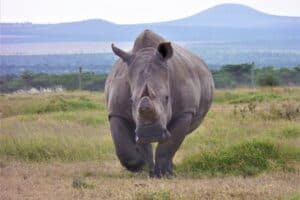The race is on to help the critically endangered animals have a fighting chance of survival through cutting-edge advances in the lab.
The world’s last two northern white rhinos, Fatu and Najin, are both female. This means that the critically endangered subspecies can no longer reproduce naturally and so extinction for the rhinos is looming with each passing day.
The race is on, however, by international teams of scientists to harness the benefits of modern science and help the rhinos have a fighting chance of survival through cutting-edge advances in the lab.
In one method being explored scientists are seeking to use skin cells from the animals to create induced pluripotent stem cells (iPS) in the lab and turn these cells into immature egg cells called oocytes.
In a major milestone, scientists from Germany, the Netherlands and Japan have succeeded in examining pluripotent rhino stem cells in depth. These cells, like stem cells, have the ability to develop into any cell of the body and so rhino oocytes could soon be generated artificially from them.
The BioRescue project, a German initiative of which the research is part, is building on the work of Prof. Katsuhiko Hayashi, a Japanese stem cell researcher at Kyushu University who in 2016 managed to generate egg cells from the skin of mice, fertilize these cells artificially, and implant them in females.
The mice conceived this way were born healthy and fertile in a landmark success. Despite those promising results with mice, however, scientists have encountered some hurdles with rhino cells.
“The iPS cells we have cultivated contain persistent foreign genetic material — namely, the reprogramming factors and the gene that prevents cell death. This means we can’t use them to make germ cells, as there is a risk these would be pathologically altered,” explains Vera Zywitza, a researcher at the Max Delbrück Center for Molecular Medicine in the Helmholtz Association who was the lead author of a paper on the findings.
However, studying these cells is helping scientists better understand the molecular mechanisms inside stem cells. “For example, we can study why the gestation period of a rhinoceros is 16 months whereas that of a mouse is only 21 days, or how organs develop in different species. This teaches us a lot about evolution,” Zywitza says.
In another development, scientists working to produce primordial germ cells iPS cells managed to cultivated ovarian tissue from mouse stem cells last year. Because primordial germ cells mature into egg cells only when surrounded by ovarian tissue, this was an important advance.
At the same time, other teams of scientists are working on assisted reproduction techniques for the rhinos and advances have been made on that front as well. Notably, scientists have just collected oocytes, or immature egg cells, from Fatu in Kenya. These cells were matured at laboratories in Italy and inseminated with thawed sperm from a dead male rhino.
As a result, there are now 14 northern white rhino embryos stored in liquid nitrogen at extremely low temperatures. The plan is to implant these embryos into southern white rhino surrogate mothers soon in the hope that healthy northern white rhino calves will emerge.
“Najin and Fatu are also closely related and their genetic makeup is largely identical. Due to age and reproductive tract issues, we were unable to collect any oocytes from Najin that could be developed into embryos, so all 14 embryos are from Fatu,” explains Prof. Thomas Hildebrandt, who leads the BioRescue research consortium.
These advances being made in the race to save northern white rhinos from extinction could one day be used to revitalize populations of other critically endangered species as well. Besides, once reproduction from stem cells is achieved, the technique could be used to revive many already extinct species.
“Generating functional eggs of the northern white rhinoceros would be the crowning achievement of our research,” stresses Sebastian Diecke, a lead researcher in the project.
More than 10,000 living cell cultures from over 1,000 endangered species are stored in the Frozen Zoo at the Arnold and Mabel Beckman Center for Conservation Research in San Diego and at a biobank in Berlin, and “this invaluable resource could be used to bring back species from the brink of extinction,” Diecke observes.
However, the scientist adds, “I would rather we never had to use our technique and did more to preserve species before it was too late.”
This story first appeared on Sustainability Times
© 2022 Sustainability Times.
This article is licensed under a Creative Commons Attribution-ShareAlike 4.0 SA International License.












